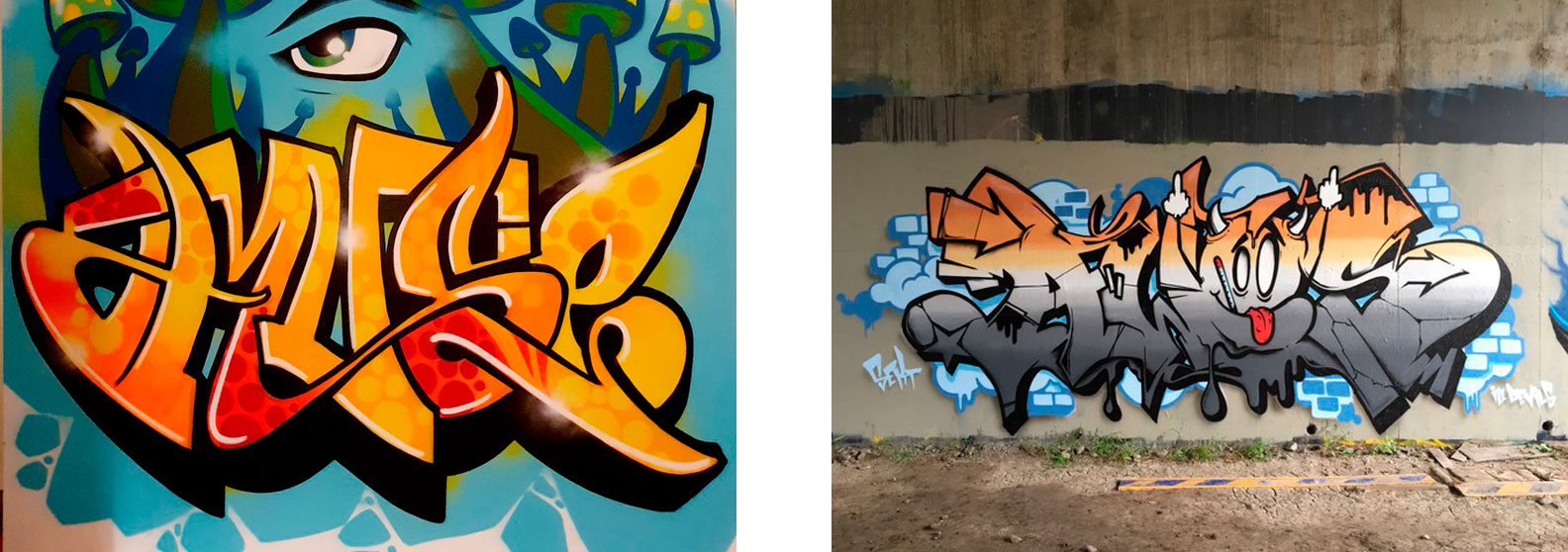The art of choosing a great graffiti tag
The art of choosing a great graffiti tag
A lot goes into a name. It is your identity and must have a good sound and contain letters you like. We reached out to some of Australia's best and most experienced writers to ask them how they chose their tag and what they think makes a great tag.
1. What do you think is the recipe for an excellent graffiti tag?
Awes - A tag must stand out, so be designed well. It should ooze style and be quick to do, so one to three lines to create the tag.
Ling - Style and flow. Ideally, a good hand style should apply to any combination of letters
regardless of the tag / name.
Amuse - First, you gotta have a good style that suits the letters you choose. If the letters are long and straight (v, f, l, n or t) better to have a taller and a long and aggressive style. If the letters are round (s, e, b or g), these can look good with a loopy and flowing style. Most importantly, practice heaps of variations on paper with pencils, pens, textas, and chisel tip pens. If it looks good with the top angle of chisel pointed at 11 o'clock, you're onto something.
Regardless of how I think, if you like it, that's all that really matters. Lastly, practice on the mist on the shower screen using 2 fingers to make a chisel tip. This and two finger dusties are good for handstyle practice.
2. Have you got any tips for creating a good graffiti name, and how did you come up with yours?
Awes - My name was all about what letters I liked, so I went to the dictionary and found a word with my preferred letters,
Ling - Anything not too silly and not too long (anywhere 4-6 letters is probably the sweet spot). Most writers move onto new names or use multiple, so there's always the possibility of changing. I find that tags often represent their owner's attitude towards graffiti. E.g. Hand styles weren't as important to me when I first started, and as a result, my tags weren't as good whilst my pieces were more technically proficient. I've only really started putting a more conscious effort into improving my tags recently after 20 years of painting.
My first tag was Linguist. I thought that was good based on graffiti being based around words. On reflection, it was a dumb word and far too long, so it was quickly shortened to just Ling.
Amuse -If you're keen on getting up a lot, find a short tag that can be made into a one-line tag; it'll serve you well later. If you want to be known for your pieces, better to have a name that represents you somehow or means something to you. The right name will keep you painting even when you doubt yourself. Most importantly, DO YOUR HOMEWORK. Only write tags not taken in your city/country unless you like getting capped.
I researched to make sure no one else was using it in Sydney. Once I got the green light, I spent ages formulating a 1-line tag that was quick, a 1-letter throw-up with an identity and stood out, a 5-letter throw-up, and many, many different amuse piece outlines. Every piece I have done is completely different, and that challenge keeps the name exciting 25yrs later.
3. How did you develop your graffiti tag style?
Awes - By practising in a sketchbook. I also looked at my favourite writer's tags and took inspiration from them.
Ling -Practice and repetition. There isn't any substitute or shortcut outside of just practising and being conscious. Pay attention to tags you like and don't like and consider why you do or don't like them.
Amuse -At first, it was in running writing with a whip at the top. Looked like a train with smoke coming out the top and was quick but not very funky. Then I tried too hard to add the funk to each letter individually, and each tag took 20 seconds - way too long and looked try hard (the worst tagging sin). So with the help of my brother's Yoke and Perso, I came up with quick versions that looked cool and, finally, 2 versions of a 1-line tag (spelt amews or amewz) which took 3 seconds each. They looked aggressive, funky and were fast. I changed the spelling of my tag to make this happen and also throw off the jacks.
4. Who is your favourite graffiti writer's tag, and why?
Awes -Futura has had many tags over the decades, and they are all great because they are original and so different. Sick WCA in Melbourne has a classic Melbourne style. Seen in the U.S.A also has a dope fast and fresh tag.
Ling -Too many to choose for any number of reasons. I'd have to go with Pzor as the hometown hero if I have to narrow it down to one. His tags are all flow and ooze style, instantly recognisable even if it isn't always legible.
Amuse -That's a hard one, so I will give you two. Phibs is a great word that he has created into a dope 1-line stylistic tag. His style is loopy and technical but effortless and instantly recognisable. In Melbourne, Peezor must be mentioned. Peezor and Zork are up all over, and his tags are all style but also aggressive with mad movement. Peezor can use a cheap chisel tip and still produce sick tags, which is not easy.
5. Do you prefer to use markers or spray for your graffiti tags?
Awes - Spray paint because I can vary the line width. I like my letters top-heavy, so I use the spray can further away at the top of my letters and bring it closer to the wall when I do the bottom of the letters. Spraycans also do bigger tags!
Ling -It depends on the surface, but I generally prefer spray. You can't hit certain surfaces or textures with a marker, whereas spray will go on everything.
Amuse - I prefer a 20mm tempera loaded up with scarring ink. I used to concoct inks out of wood stain, brake fluid and raven oil until I was shown Niro D'Inferno and Corio. Part of staying up is tagging where they don't buff or tagging with ink that they can't buff. Knowing your ink is important. You can dack a pen if you get searched, and they are less messy (but always wrap a pen in a small glad bag before you dack it).
I love spray paint, but it's best used with gloves when on the lines thrashing or hiding in a bush doing run-ups. Again, always pick paints that scar. Engine enamel or, at the very least matt black. Staying up is what it's all about.
Want to be a street artist? Here's Dan's top five tips
As a self-taught street artist, I've learnt so much over the years.
I've put together my top tips, with detailed info I wish I'd known. From developing your style and ideas, to setting up your kit, I hope my tips will help and inspire you to keep creating art.


Our Services
- MuralsGraffiti and street art murals for anywhere - hospitality, office, residential...01
- Brand ActivationsBranded live graffiti for product launches & brand activations. 02
- EventsLive artwork production by graffiti and street artists for events.03
- Removable ArtStreet art and graffiti prints, canvases and wallpaper.04
- DesignLogos, rebranding, graffiti and street art graphic design for print and digital.05
- WorkshopsLearn to paint with a spray can via a graffiti workshop experience.06
- Content CreationFilm a mural being painted and share the content on socials.07
- MaintenanceCare and upkeep of outdoor and indoor graffiti and street art murals.08
Read more about our services. Learn about our process.







